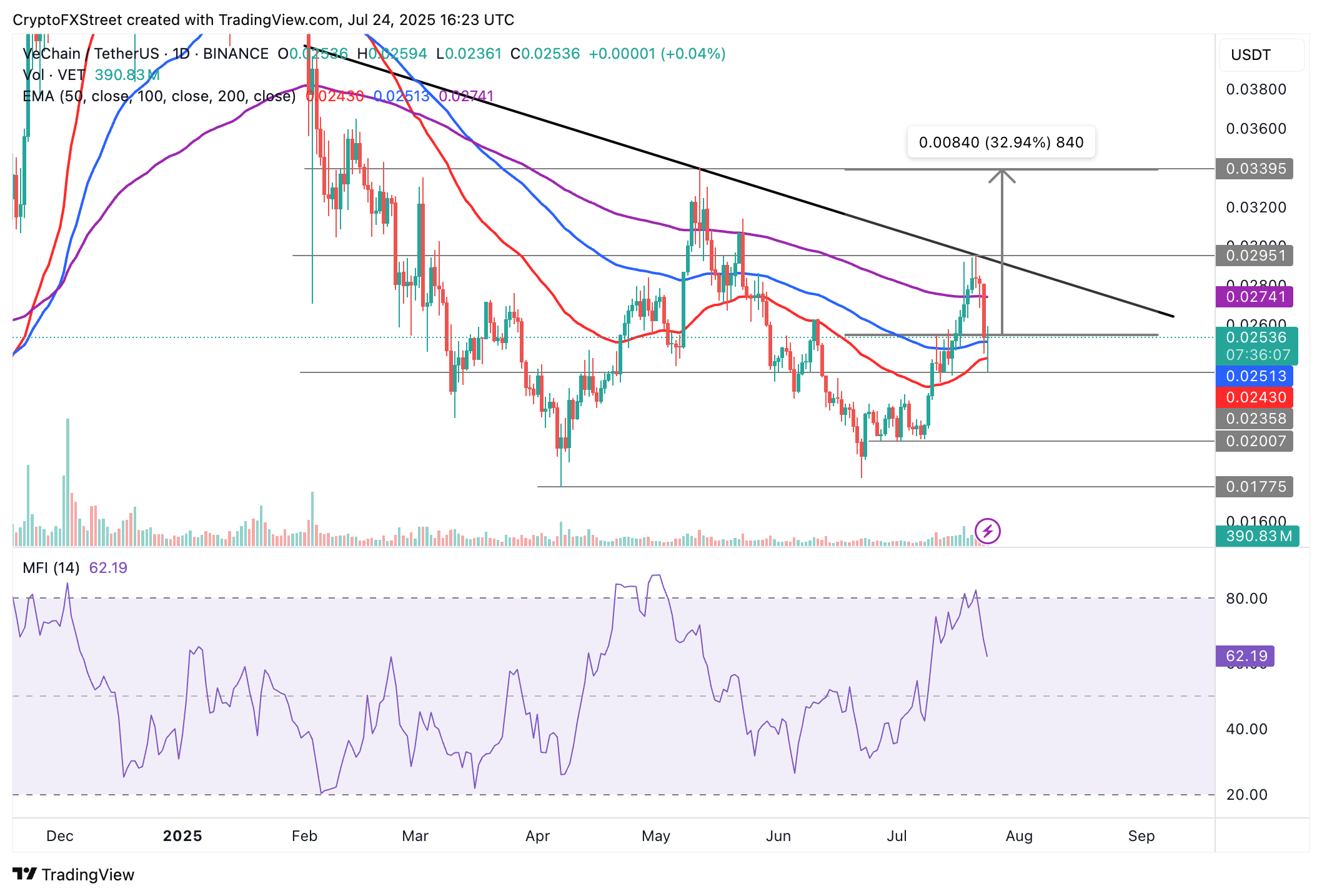VeChain eyes 33% surge after unveiling strategic partnership with Franklin Templeton, BitGo and Keyrock
- VeChain rebounds, stepping above the 50-day and 100-day EMAs backed by institutional adoption developments.
- Franklin Templeton, BitGo and Keyrock join forces to build the future of web3, advancing the adoption of tokenized assets.
- VeChain will leverage Franklin Templeton's BENJI platform and the $800 million FOBXX fund to support B2B transactions.
VeChain (VET) price shows signs of extending its recovery, trading at $0.0253 on Thursday, backed by developments in institutional adoption. The enterprise-grade Layer-1 smart contract token, tested support at $0.0251, marking a 20% decline from its July peak of $0.0295, mirroring the risk-off sentiment in the broader cryptocurrency market.
VET could extend the recovery and break above a key descending trendline on the daily chart if interest in the token increases, following the announcement of a major collaboration with leading institutional players, including Franklin Templeton, BitGo and Keyrock.
VeChain, BitGo and Keyrock announce support for Templeton's BENJI platform
VeChain announced on Thursday that it was joining forces with key institutional leaders, including Franklin Templeton, BitGo and Keyrock, to support the advancement of tokenized assets on the backdrop of the establishment of clear regulations for the crypto industry in the United States (US).
"Together, we're building a robust environment for enterprises and investors to engage with tokenized assets on a foundation of sustainability, regulatory compliance, new staking products via StarGate, and technical excellence," VeChain said in a press release published on X.
VeChain will leverage the newly launched Franklin Templeton BENJI platform, as well as the $800 million FOBXX fund, to enable business-to-business (B2B) transactions. BitGo will provide custody services, while Keyrock is expected to develop derivatives trading solutions and a new validator client to enhance scalability.
Franklin Templeton launched the BENJI platform to support enterprise payment solutions and expand the company's multi-chain strategy. The platform extends support to the Franklin Templeton OnChain US Government Money Fund (FOBXX).
"Franklin Templeton, BitGo and Keyrock are some of the best names in their respective fields. Bringing them together on VeChain offers institutional investors an unrivaled value proposition that is overlaid with a long-term, sustainable mindset," VeChain's co-founder and CEO, Sunny Lu, said.
VeChain's price reacted positively to the news, but its price remains suppressed, reflecting a weak technical outlook. The next few sessions could provide insights into the direction of the trend.
Technical outlook: VeChain upholds key support
VeChain is trading above the support provided by the 100-day Exponential Moving Average (EMA), currently at $0.0251, and the 50-day EMA, which is slightly below it. The 200-day EMA at $0.0274 could delay the uptrend, but if broken, traders could expand their bullish scope to $0.0339, marking a 33% increase from the current level.

VET/USDT daily chart
Still, a recovery seems elusive, particularly with the Money Flow Index (MFI) indicator declining to 62 after peaking at 82. The MFI indicator tracks the amount of money flowing into or out of VeChain.
A persistent decline suggests a risk-off sentiment as traders reduce their risk exposure. If the MFI continues to drop, VET could accelerate the decline below the 50-day EMA at $0.0243 toward support tested at $0.0200 early this month.
Bitcoin, altcoins, stablecoins FAQs
Bitcoin is the largest cryptocurrency by market capitalization, a virtual currency designed to serve as money. This form of payment cannot be controlled by any one person, group, or entity, which eliminates the need for third-party participation during financial transactions.
Altcoins are any cryptocurrency apart from Bitcoin, but some also regard Ethereum as a non-altcoin because it is from these two cryptocurrencies that forking happens. If this is true, then Litecoin is the first altcoin, forked from the Bitcoin protocol and, therefore, an “improved” version of it.
Stablecoins are cryptocurrencies designed to have a stable price, with their value backed by a reserve of the asset it represents. To achieve this, the value of any one stablecoin is pegged to a commodity or financial instrument, such as the US Dollar (USD), with its supply regulated by an algorithm or demand. The main goal of stablecoins is to provide an on/off-ramp for investors willing to trade and invest in cryptocurrencies. Stablecoins also allow investors to store value since cryptocurrencies, in general, are subject to volatility.
Bitcoin dominance is the ratio of Bitcoin's market capitalization to the total market capitalization of all cryptocurrencies combined. It provides a clear picture of Bitcoin’s interest among investors. A high BTC dominance typically happens before and during a bull run, in which investors resort to investing in relatively stable and high market capitalization cryptocurrency like Bitcoin. A drop in BTC dominance usually means that investors are moving their capital and/or profits to altcoins in a quest for higher returns, which usually triggers an explosion of altcoin rallies.

